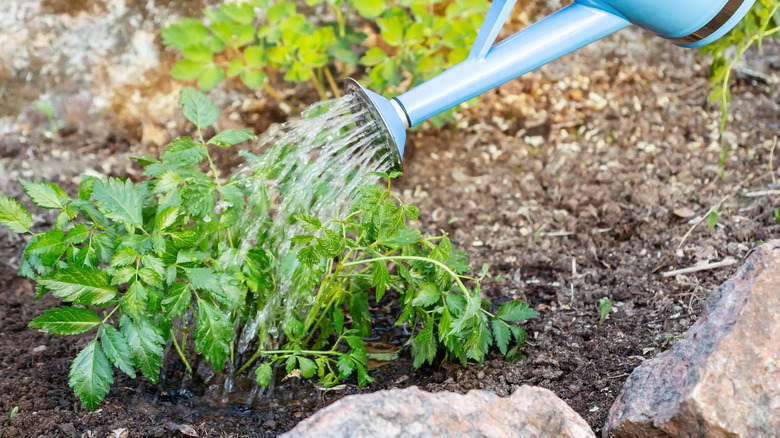How To Make Sure Your Astilbe Survives The Winter
If we were to create a rundown of the best flowers for your garden that history was unkind to, astilbe plants would be on it. Roughly meaning "without brilliancy", these ornamentals are anything but. Exhibiting spectacular pyramidal panicles hued white, scarlet, or lavender, these graceful swayers are your go-to if you're looking for shade-hogging, moisture-loving plants that aren't too difficult to care for. Although they're moderately cold-tolerant—being hardy in USDA zones 4 to 9—they still need winter care to bloom the healthiest blossoms in the next season. Thankfully, you don't have to look for blankets and burlaps to cover growing astilbe plants, as snow adds to their aesthetic appeal without harming them—unless the temperature dips below -28 degrees Celsius (-18.4 degrees Fahrenheit).
But you must keep the soil moist enough for them to sail through mercurial fluctuations comfortably. However, container-planted astilbes are different, as they usually fork around the pot and are deprived of the soil's natural insulation. If left uncovered, the roots are exposed to cooler air temperatures, leading to winter injury, especially when the soil cools beyond 15 degrees Fahrenheit. While this isn't overtly concerning for those in zone 5 or further down, the rest should move the containers indoors to a frost-free location like a garage or a shed. Wrapping in thermal sheets or plastic-straw layers can help, too.
Pre-winter astilbe care
Overwintering astilbe plants requires some fall prep. If the flowering plant is aged between 1 and 3 years and has grown considerably, divide it at least four weeks ahead of the first frost to improve its flowering come spring. Separate its rhizomes and plant them 1 to 3 feet from the mother perennial. Otherwise, prune the herbaceous plant to three feet above ground once it stops blooming.
Consider keeping the dead inflorescence on, as it serves as a picturesque background for your snowman. Besides, if you enjoy maintaining an animal-friendly lawn, it can double up as food and harborage spots for hungry critters. But if your cultivar is prone to self-seeding, remove the spent blooms—it won't encourage new flowers—and add them to your compost pile or flower arrangements. Meanwhile, feed the plant a phosphorus-rich fertilizer, such as a granular 5-10-5, when it's sufficiently cold not to stimulate growth. Continue deeply soaking your astilbes every week until the soil freezes.
Overwintering astilbe plants
Winters can't stop the astilbe plants from craving water. So, irrigate them around noon at least once or twice a month when it gets too dry—preferably when it's over 40 degrees Fahrenheit with no signs of snow—lest they desiccate and suffer root injury. Water more if the area is prone to dry wind action. You can keep your flowering perennials happy by mulching the soil. Spread a two-inch-wide layer of shredded leaves, compost, or humus around the roots to retain moisture and provide winter insulation. Do so only when it's freezing cold, or the soil may become waterlogged, causing root rot.
When temperatures dip below 20 degrees Fahrenheit, shield the ground-planted astilbes with brushwood and bubble wrap the containers, although blankets, burlaps, and their ilk work, too. Even better, move the pots to a dark, sheltered, cold area. Finally, add a screen to keep pests away. Around early spring, right about when they start growing new stems, replace the mulch. Also, be wary of late spring frosts, as they can damage your plant.


